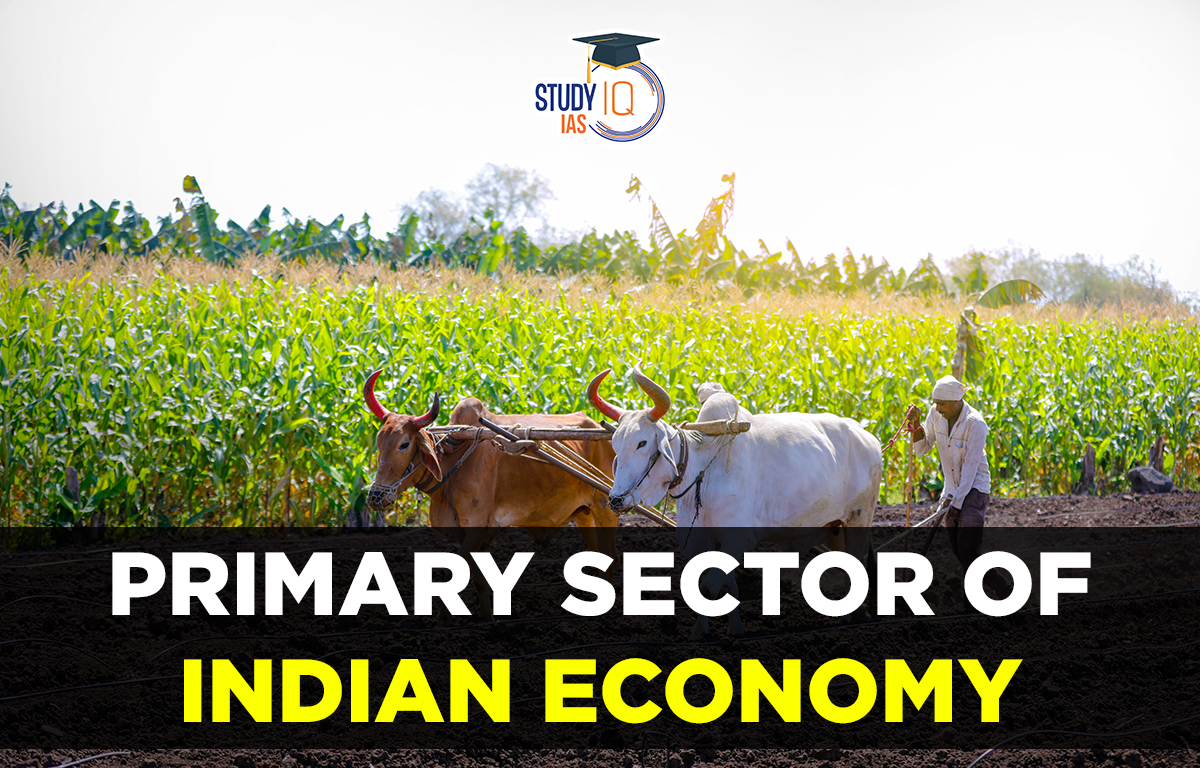Table of Contents
Primary Sector of Indian Economy
The consumer products we buy come from many different job sectors, starting with the primary sector. This sector is the first step in making things and focuses on getting raw materials. Jobs in the primary sector include farming, mining, and fishing.
The primary sector involves industries that collect raw materials for other parts of the economy. It is called the primary sector because it is the base for all other products. Most natural products we use come from agriculture, dairy, forestry, and fishing, so we can also call this sector the agriculture and allied sector. Companies in the primary sector extract, harvest, and gather natural products from the earth and animals.
Sectors of Indian Economy
The three-sector model in economics divides the economies into three sectors of activities.
- Primary Sector: This sector involves getting raw materials from nature, like farming, logging, hunting, fishing, forestry, and mining.
- Secondary Sector: This sector focuses on making products from raw materials, like manufacturing and industrial production.
- Tertiary Sector: This sector provides services that help transport and distribu
Read More: Coastal Landforms
Primary Sector Examples
The primary sector refers to the part of the economy that involves the extraction and harvesting of natural resources. Examples of primary sector activities include Agriculture, Fishing, Mining, Forestry, Hunting, gathering etc.
Agriculture & Allied Sectors
Agriculture is a primary economic activity of the world because it involves direct utilization and exploitation of nature and components of nature, such as soil, climate, landforms, and others. According to the definition, primary economic activities include the following types of activities,
- Agriculture (Growing crops, raising livestock, and other farming activities)
- Hunting and gathering of fruits and roots of the forest.
- Animal rearing,
- Fishing (Catching fish and other seafood from the ocean, rivers, and lakes.)
- Mining (Extracting minerals and other resources from the earth, such as coal, oil, and natural gas.)
- Collection of forest products
- Water extraction (Collecting and transporting water for irrigation, drinking, and other purposes.)
- Collection of mineral resources, and so on.
Read More: Types of Soil in India
Importance of the Agriculture Sector
Agriculture is an essential primary economic activity in the world. Nearly half of the world’s population is still dependent on agriculture. About 65 per cent (65%) of the population in developing countries earn their livelihood by practising agriculture. Agriculture is the basic activity; because it is the only activity that provides food security to people. Agriculture provides raw materials to many basic industries (secondary activities) like textiles (jute, cotton, silk), tea, sugar, and oil.
Read More: Types of Rocks
Influence of Agriculture on Environment
Agriculture is closely linked to the environment and relies on various environmental factors. Different farming methods and crop types result from these varying conditions. These environmental conditions can be divided into two groups:
- Physical Environment
- Non-physical or cultural environment
Read about: Glacial Landforms
Physical Environment
It includes the physical surroundings such as Topography, Soil, Climate etc.
1. Topography
Agriculture methods and crops vary based on the landscape. Rocky mountains are not good for farming. Sometimes, hills are terraced to create small farms, but machines can’t be used there. Terraced farming is common in hilly areas of India, China, Japan, and Indonesia. Crops like tea and coffee grow well on hill slopes because the soil drains well. Plains, floodplains, and lowlands are perfect for farming, and most of the world’s farms are found in these areas.
2. Soil
The soil is composed of various minerals and organic substances from the physical support of plants. The yield depends on the fertility of the soil and the type of crops selected to be grown in that particular soil. Agriculture is practised in regions where the soil is fertile and rich in plant food.
3. Climate
Climate is the most important physical factor for agriculture. It affects the types, quality, and quantity of crops. Each crop needs conditions like temperature, rainfall, humidity, wind, and growing season length. Rainfall and temperature are the most important. Different climates lead to different crops, which is why we have a wide variety of crops around the world.
Read More: Climatology
Non-Physical or Cultural Environment
It includes factors related to population, economic condition, technological development, governmental policy, etc.
1. Population
Population affects agriculture. High population density influences farming activities by providing more workers. In Southeast Asia, rice and tea plantations thrive because of the availability of cheap labor.
2. Economic Condition
Agriculture happens in areas where it makes economic sense. Before rubber farming began, much of Malaysia’s land was left as forests and unused. The types of crops grown depend on local needs or commercial demand. So, the growth of agriculture relies heavily on economic factors.
3. Technological Development
Modern technology, particularly the use of tractors and other implements and the extension of railways, has helped to bring new areas under agriculture. New methods of cultivation and technology, particularly the use of chemical fertilizers and hybrid seeds, have facilitated the production of crops.
4. Governmental Policy
The government directly influences farming. It protects farmers by imposing tariffs and restrictions on imports. For example, after India’s partition, large areas in West Bengal and Assam were used for jute farming due to subsidies and tax relief. The government also conducts agricultural research, shares new findings with farmers, and promotes new farming methods. Sometimes, it provides loans to help develop agriculture.
Read More: Tropical Climate
Primary Sector UPSC
Since agriculture is the most significant and substantial sector of the Indian economy, the agriculture sector is relevant here. However, underemployment is a significant underlying problem in this industry. For the UPSC/IAS preparation, this article is useful.
Read More: Natural Vegetation of India


 Goods and Services Tax (GST), Objectives...
Goods and Services Tax (GST), Objectives...
 World Oceans Day 2025, History, Theme, S...
World Oceans Day 2025, History, Theme, S...
 World Environment Day 2025, Theme, Histo...
World Environment Day 2025, Theme, Histo...





















